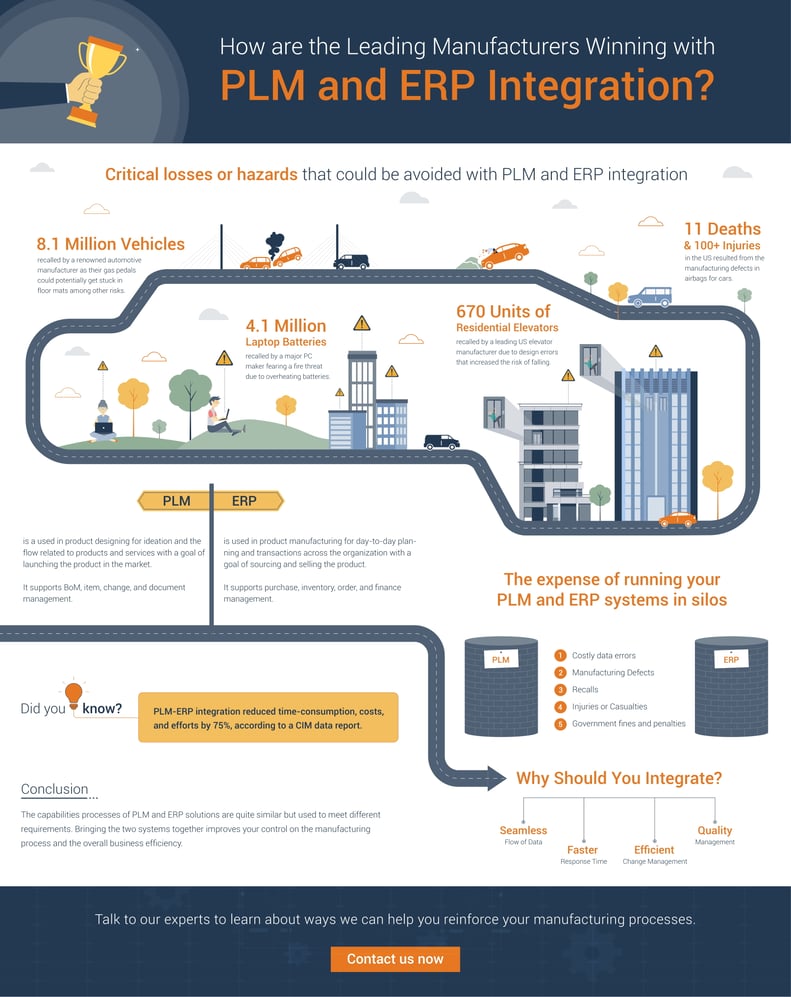Product Lifecycle Management (PLM) and Enterprise Resource Planning (ERP) are two critical business units in a manufacturing company. While PLM manages the planning and engineering, ERP handles the production and operational aspects.
Both databases hosting critical information must be able to ‘talk to each other’ to ensure a smooth flow of information. Connecting PLM and ERP using an integration solution results in a synergistic effect, boosting your business’s growth.
Having been in the manufacturing industry for over 18 years, we at To-Increase have helped many leading manufacturers maximize operational efficiency by integrating their PLM and ERP systems.
This blog will share the key challenges of disconnected PLM and ERP and how PLM-ERP integration can help your manufacturing business succeed.
What are the challenges of disconnected PLM and ERP?
The various processes that occur in your PLM and ERP systems are closely interconnected. The same product data flows through both systems across different functional departments.
When PLM and ERP work in silos, there is a significant risk of data error, which eventually leads to wastage of time and costly or irreversible scenarios. Data silos are one of the main reasons firms are unable to use insights to drive business decisions, according to a Forrester report.
Some disadvantages of not integrating your PLM and ERP are:
- Increased workload with a manual import process
- Data duplication due to no ownership
- Inability to transfer and manage bill of materials
- Lack of visibility due to inconsistent supply chain
- Failure to maintain data quality and integrity
- Engineering and logistics confusion due to communication gaps
- Tracking product revisions, versions, and changes
- Additional costs and expenses due to process lags
- High time to market and decreased productivity
- Data errors that cause loss of money and reputation
- Defects in final goods leading to expensive recalls or penalties
|
Related reading: 10 Challenges of Disconnected PLM and ERP Systems |
How can PLM-ERP integration help manufacturers succeed?
Integrating your PLM and ERP systems can streamline communication in a centralized manner. It allows seamless movement of information between engineering and manufacturing teams while maintaining data quality and integrity. This improves cohesion and collaboration among different departments and increases overall productivity.
Here are some of the ways integrated PLM and ERP can help you succeed as a manufacturing company:
- Seamless flow of data between the two closely related systems
- A shorter response time with a unified view of the data
- Clear visibility on items, item fields, BOMs, status, and reporting
- High-quality data management with a lowered risk of errors
- Efficient change management of product data and versions
- Better project management with the ability to track project variables
- Smoother supply chain with end-to-end visibility of processes
- Saved time and money by ensuring accurate shipping of products
- Increased operational efficiency with real-time access to data
- Decreased errors with automated data transfer processes
- Strengthened interdepartmental collaboration with streamlined communication
- Increased customer satisfaction and improved customer relationships
- Stronger competitive positioning in new markets
In summary, with PLM-ERP integration, you can track the product lifecycle and monitor product data quality – from conception to manufacturing and distribution, improving efficiency and reducing costs you would otherwise incur in damage control.
Here is a graphical overview of how manufacturers can achieve success with PLM-ERP integration
Do you want to succeed with PLM-ERP integration today?
Integrating your PLM and ERP systems is an excellent way to initiate operational efficiency and streamlined communication. As a manufacturer, you can store and access all product-related data in one digital location, offering a quick overview of your product lifecycle.
If you are in a specific industry, you can use the relevant links below to learn more about how PLM-ERP integration benefits you and addresses critical business concerns:
- Aerospace manufacturers
- Automotive manufacturers
- Semiconductor and electronics manufacturers
- Engineer-to-Order manufacturers
Here are the next steps you can take to decide on a PLM-ERP integration solution:
1. Discuss the idea of a PLM-ERP integration with your engineering, manufacturing, and other teams.
2. Analyze your PLM and ERP systems and the data it hosts.
3. Review software vendors that provide integrations for your systems.
4. Explore your options based on predetermined factors such as budget, ROI, and features.
5. Select a solution provider with the most relevant experience based on your business case.
How can we help you integrate your PLM and ERP?
If you use (or plan to use) the Microsoft Dynamics 365 ERP system, check out our PLM-ERP integration solution for D365 F&SCM. It is an intuitive, easy-to-use solution that seamlessly connects your engineering and manufacturing worlds.
We offer out-of-the-box PLM integrations for Siemens Teamcenter and PTC Windchill. Additionally, we provide a PLM integration framework that you can easily configure for other PLM, PDM, or CAD systems.
You can learn more about our PLM-ERP integration solution by downloading the solution factsheet.
Alternatively, if you want to know the details of the benefits of PLM-ERP integration and how it impacts manufacturers, review the guide linked below.






